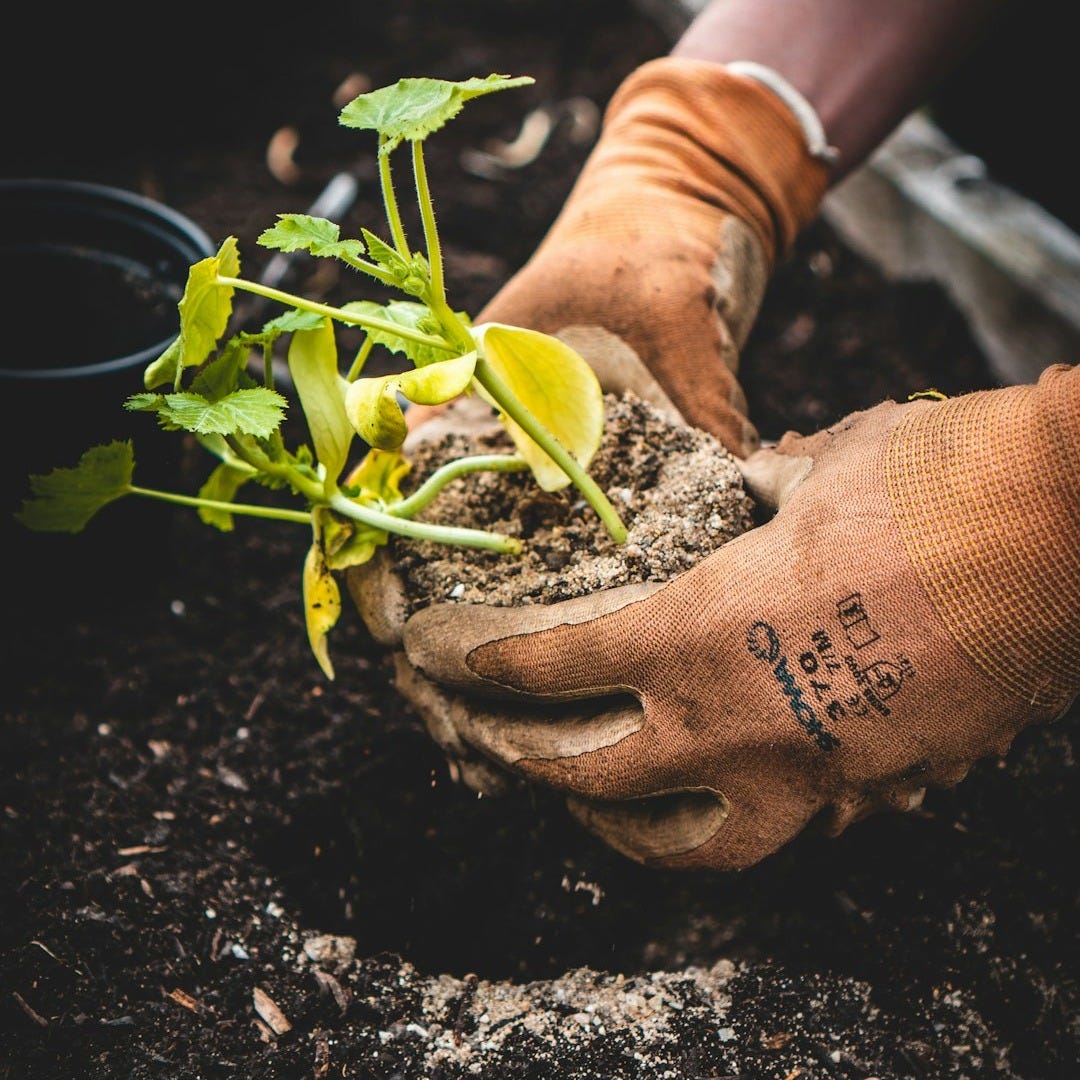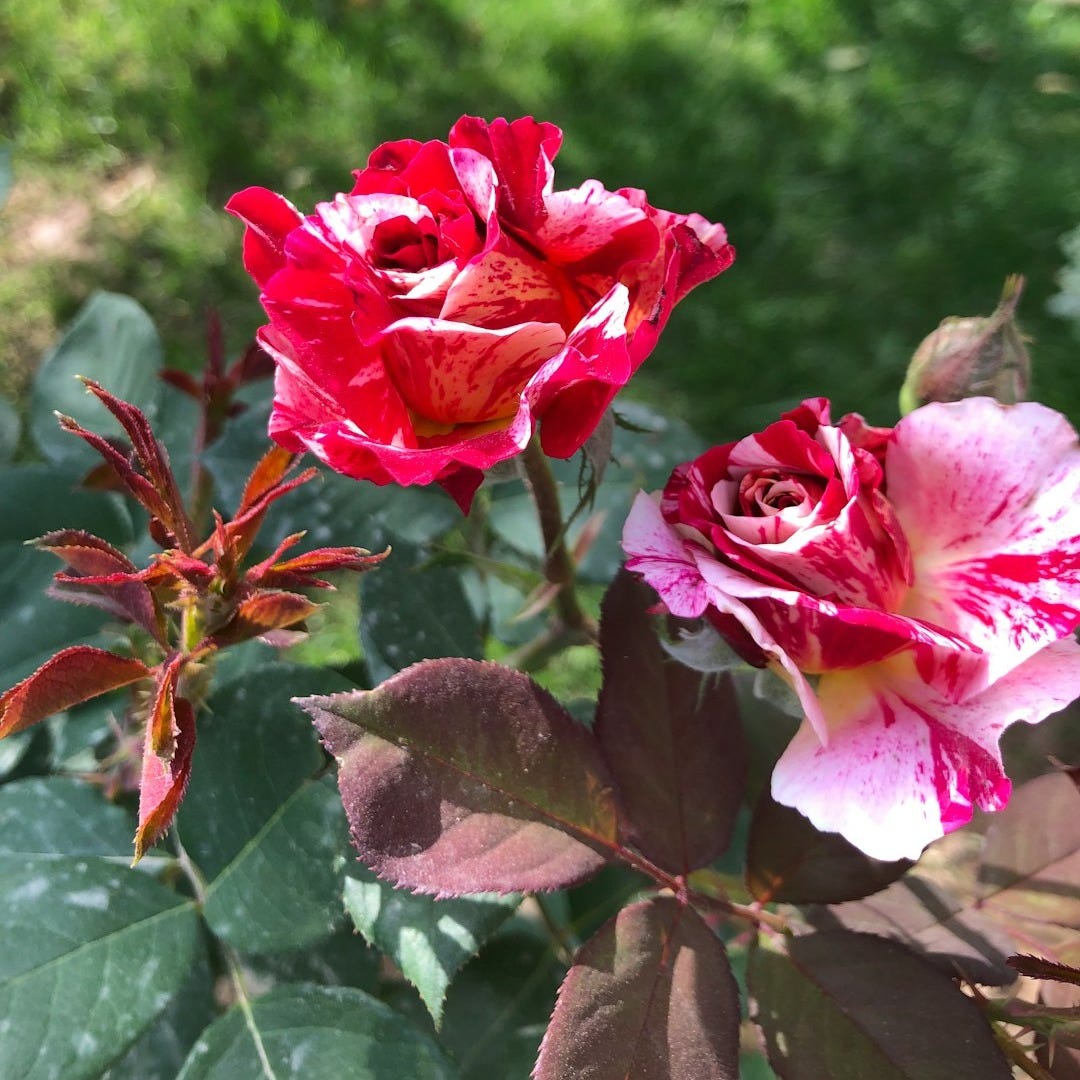Tending Living Things
Lessons on Writing from the Garden

I couldn’t bring myself to sit down and write. The “reviewer number two” voice in my head was so strong, constantly telling me my argument was weak, my writing was unclear, and that I wasn’t good enough. This voice had become paralyzing.
I started working with Jenn a few months ago to work through my writing anxiety. We didn’t start with craft or structure—we started with how I felt when I wrote, the pressure I put on myself, and the fear of not measuring up. I began to notice how often I was writing from a place of fear rather than curiosity and how that shaped not just my writing but also my relationship to it. “Reviewer Number Two” is now quieter and I’ve been able to replace this voice with ideas and practices that bring me joy, like gardening.
I use gardening as a way to connect with my father—who farmed in his youth and comes from a long line of Brazilian coffee farmers—and, also, to cultivate my own sense of quiet. What started as an escape from my desk has, bewilderingly, helped me to develop a healthier writing practice. Let’s walk through each phase.
Seeds
In March, I started my gardening journey by planting herb seeds. I lovingly embedded basil, oregano, chamomile, parsley, and cilantro into soil housed in old egg cartons. Over the course of six weeks, I watered them daily. I noticed how this process was similar to writing for thirty minutes a day—watering my ideas daily by writing them out. There was no way to unequivocally know how many seeds would germinate or even whether they would germinate at all. The only thing I could do was to keep an eye on the soil and water as instructed. So, I noticed the same goes for writing. I started to talk myself out of the daunting question “What will this become?” to instead write down my musings, questions, and ideas in a coherent way.
Seedlings
I gasped when I saw that the seeds I had watered so tenderly for weeks finally poked through the soil and grew into delicate seedlings. What pure and delightful joy. I observed how I tend to feel the same way when I write through an article manuscript from beginning to end. I love the sense of contentment I feel when I’m finally looking at a written document and not the dreaded blank sheet of paper.

The seedlings—like an article manuscript—are so delicate at this point. The seedlings can’t be outside because the wind and temperature changes would kill them outright. During this phase, seedlings (and manuscripts) need warmth. At this phase of writing, I like to send early drafts to my writing group—the four women who started off as friends in graduate school and, now, have become family. Their generosity, warmth, and constructive criticism never fail to strengthen the piece. I continue to write daily, incorporating my writing group’s feedback. Like my seedlings, the article manuscript grows and, sometimes, in a completely different direction than I expected.
Transplanting Seedlings
This is the make-or-break moment. Will the seedlings that I have patiently cultivated over a period of eight weeks brave the outside elements and pests? How about that article manuscript I have spent twelve weeks writing, editing, citing, and cross-referencing? You will never know until you plant the seedlings and send that manuscript out into the world. Any gardener will tell you how growing anything to fruition—herbs, food, or flowers—is not always guaranteed.
This year, every one of my (many) seedlings died. My basil became an aromatic food for insects. The cilantro wilted. The oregano and chamomile were burned to a crisp in an unexpected spate of hot weather. I couldn’t control any of these events. Although it stung, none of this took away the joy I experienced as I worked through the process of germinating and transplanting. I let myself feel sad about this failure, and afterwards, I thought about how to do things differently for next year.
Like my herb garden, my article manuscript didn’t work out. It was rejected from two journals. Again, I gave myself some time (and ice cream) to work through my feelings. I talked to friends so that, in community, I could release that disappointment. Afterwards, I was able to read through the kind reviewer comments—seriously, they were incredibly nice—and I saw how their ideas would make the piece stronger. Allowing myself the time and space to feel the disappointment helped me to better visualize the beauty of the writing process. More importantly, it allowed me to see the bigger picture regarding how to make this work stronger, find my voice, and get this piece into the world.
All my seedlings are dead. What do I do now?
With the abrupt death of my seedlings, I was able to look up from those tiny little seedlings and observe beyond them. What did I see? An entire garden filled with shoots from every nook and cranny. Lilies, roses, mums, and hydrangeas were poking their heads up from the last spring frost. While I had been so hyper-focused on a micro-project—the herb garden, the article manuscript—there was a whole garden of thought that needed cultivation. I realized, then, that academic writing is not about a single piece of writing. Rather, I have found more peace in cultivating a mindset of academic writing as a process of carefully arranging various plants (pieces of data and theory) to create a new landscape of thought.
This mindset shift made it easier for me to acknowledge and deal with failure. Killing the herbs did not mean the whole garden was dead. I had so many other pieces of the garden coming alive, and the herbs were a small piece of a new landscape. I could try something new with the space that had just opened up—all I needed was some courage.
The courage to keep trying and failing helped me become a better gardener. I knew about different kinds of plants and their needs, invested in gardening tools, and had gotten familiar with uncertainty. I had already killed over fifty seedlings; what else could go wrong? All that was left to do now was quite literally to roll up my shirtsleeves and get to work. I pruned the roses and the mums, then transplanted the hydrangeas to a shadier spot. Finally, I doused the lilies with pesticide so the scarlet lily beetle would stop eating through the leaves.
If the survival rate of these perennials is any indication, I’m now a decent gardener. Maybe I was a decent gardener all along, and herbs just weren’t the right project for me. Who knows? What I can tell you for certain is that the vast majority of these flowers are thriving. I have so many roses that I have to actively prune them so that others may blossom in their stead. As I enjoy these blossoms and their vibrant colors, I can see how killing my herb garden helped me to let go of my fear of failure. Yes, killing my herb garden shook my confidence, but more importantly, it strengthened my resilience and courage to try again (and again).

As you may have guessed, my writing practice fared similarly. Getting two rejections and helpful comments helped me to visualize how this article manuscript was only a small part of a broader argument. I had developed a consistent writing practice, learned how to make my theoretical contribution smaller, and overcome my fear of rejection. It had already happened twice; what was another time going to do to me? Two other times?
With the fear of rejection gone, I returned to my desk and continued writing. The manuscript needed plenty of pruning and then shaping in the form of clear transitions and a strong voice. This is where I find myself today. I am almost ready to send this article manuscript out for a third time. The publishing process—much like my gardening—has wildly diverged from the timeline and vision I had intended. When I find myself worrying over my pipeline and employment prospects, I remind myself that rigorous scholarship takes time. You cannot rush growth.
I have learned that gardening and writing are both the process of tending to living things. Ideas, like plants, need consistent watering and support to bloom. Sometimes, you can tend both lovingly and tenderly and still fail. I deal with the frustration and disappointment by telling myself that this is part of working with living things. All kinds of life—people, ideas, and plants—have their ways of working themselves out that were not what you envisioned, but you learned so much along the way. The key is to apply this knowledge when a different opportunity presents itself.
Karolina M. Dos Santos, Ph.D., is a sociologist who studies how Black liberatory practices have socially, politically, and geographically shaped her hometown of Newark, NJ. Currently, she is finishing up her postdoc at NYU Gallatin. In her free time, you can find her sipping cafecito/cafezinho in her garden or at the domino table.




Absolutely love this!
I love this as a way of thinking about what else is potentially flourishing while we're head-down focused on a particular project. Hm!!